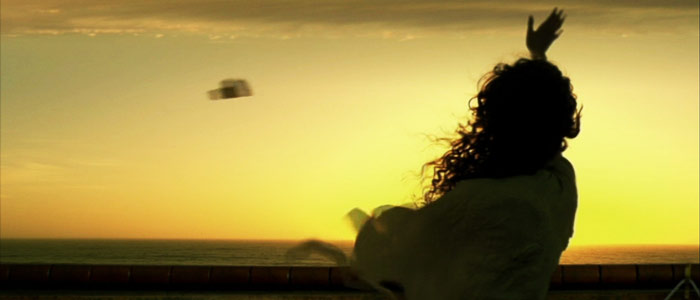Playing as part of the Reel Film Club, Tuesday, July 26, 2011, 6:00pm
Instituto Cervantes 31 W. Ohio St. Chicago, IL | 6 pm : Wine & Hors d’ oevres, 7 pm : Film screening start
Use code “Gozamos” for 2 for 1 discount when ordering at 312-431-1330
Children staring helpless and forlorn from a car window. Monochromatic filters of the cinematography snuff out every trace of warmth. A woman who must be the mother follows trembling and heaving in sobs. Pensive, conflicted man at the wheel, driving away, forever and ever. What might be the most tragic part of the scene is that the children aren’t screaming; they’re just silent. They’re not crying out for their mother. This is important for children are apt to let all sorts of sins go when it comes to their mother and separation from her. But not these children. The mind aches at the sway and pull of how things came to be this way and how they will end up.
And so, this is a tragic way to begin a film. Before the mystery gets enough air to move along the plot, we realize what’s quietly residing on the edge of the screen: París, 1921. Perhaps that’s all we need to know, for the roar of the 1920’s consumed just as much in Paris as it did in the States. And in Tatiana Gaviola’s newest film, Teresa: Crucified for Love, we see that these same fires burned just as bright in not just Chile but in the woman, the mother, the poet Teresa Wilms Montt.

Born in Viña del Mar, Chile on September 8, 1893, Teresa Wilms Montt grew up in a family of considerable wealth. She was also beautiful. Very, very beautiful. This was well realized on screen in the casting of actress Francisca Lewin, a woman who looks like an older, scrappier – in a very good way – Emma Watson. Thankfully, her beauty is matched and surpassed by her incredible scope and craft. Such casting was crucial, for the role of Teresa consumes much of the movie, is the movie. At times, this focus seems to be at the expense of a more complicated storyline. Namely, we miss out on what made this story worth re-telling: the poetry. Teresa Wilms Montt was a poet of the highest caliber. Unfortunately, this is news to much of the world
“This one,” says a man to Teresa as he sifts through papers. She snatches the paper out of his hands and begins to read aloud in a pub full of men. “Absent. Boredom. Anxiety. Tenderness. All of them I feel at once. How? If even in shadow. Your breath haunts me. Since you left. Absent. Boredom. Anxiety. Tenderness.”
This is the first poem of Teresa’s that we hear. There’s nothing spectacular in her prose, but for the time, in a world that was still reeling from the sensual writings of Whitman, in a world in which women weren’t yet deemed worthy of voting rights, the poetry ceased to be mere words on a page but an act of defiance. But instead of protest and social movements, we see time and again Teresa struggle with men.
When things sour with her husband, she finds love with her husband’s cousin. Things get worse. Eventually, Teresa is placed in the care of nuns. But another man comes to her aid. And then there’s another. These are the larger seismic shifts of the plot. Smoldering underneath is an absence that’s easy to forget for we see so little on screen: Teresa’s children.
Such omission of something so great might seem the mark of poor storytelling. If Teresa suffered so from being away from her children, why did we not even see the second child aside from the very beginning of the movie and then again at the end?

This is the minimalist style of director Tatiana Gaviola. In this way, it takes a sensitive audience to realize the absence of such a force in Teresa’s life as well as an audience familiar enough with history to know just how turbulent a time it was in the early 20th century. By trusting us so much, Gaviola was able to focus much more on the person of Teresa, as if to let us look upon her just enough for a resurrection in our hearts and minds. What is crucified must return once again, at least this one time.
Reflecting the beauty of Teresa is the beauty of the film itself. Director of photography Juan Carlos Bustamante and art direction helmed by Hugo Tripodi work together to capture the arid highlands of Chile as well as the dress of the times. Other scenes are so artfully rendered, one is wont to pause the moment and linger at such gorgeous juxtaposition of costume with scenery. There certainly is a feeling of Merchant Ivory in their storytelling. Early on in the first act of the film, Teresa is nestled in a thicket of ivy, thinking to herself as a poet can do so well. From above, the camera takes her in, upside down. This shot so early on suggests what’s to come will certainly mirror a similar, artful rendering. And Teresa does not disappoint.
Scored by Juan Cristóbal Meza, the movie feels like it is haunted with aural ghosts hovering just long enough for you to notice, only to fade soon thereafter. Scenes reverberate with gentle, sullen strings, the dark and rich somber tones of clarinet and a sorrow only a lone piano ambling along can convey. While the opening scene took only moments, the music holds on to such torment and makes it a beautiful but ever-present sadness.
This is one of those movies that highlights just how terrible it has been for women. While the subtitle of the movie suggests this is a story about someone who was crucified for love, it could easily say that she was crucified for being a woman. But the misogyny genre isn’t as attractive as that from which the likes of Romeo and Juliet reside. In this way, Teresa necessitates more than just reflexive watching. And perhaps this is the best homage to such a fallen light.